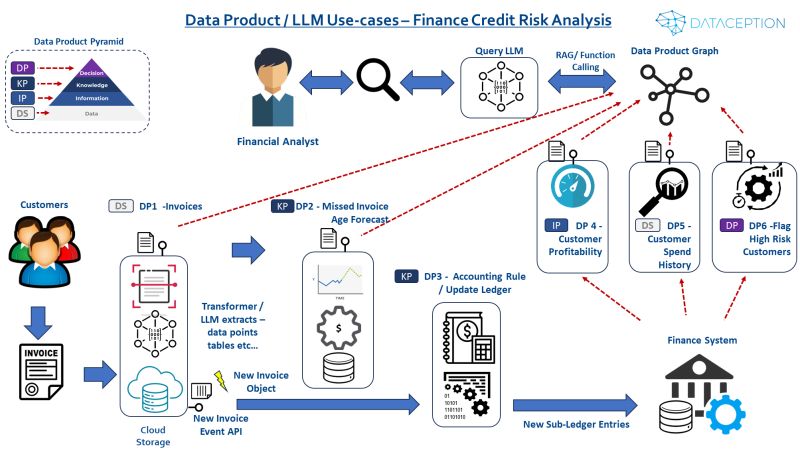In today’s rapidly evolving business landscape, the concept of a "Composable Enterprise" is transforming how organizations operate. By leveraging interconnected AI, large language models (LLMs), and analytics data products, businesses can create an adaptive ecosystem that dynamically reconfigures as the market and internal needs change.
Simplifying the Complex: A Finance Domain Example
To illustrate this concept, consider a simplified example within the finance domain, focusing on the invoicing process. Here, various data products perform different steps across business and analytics processes. These steps include capturing data from invoices, updating the finance system, and calculating credit risk exposure.
Each data product in this example aligns with the Data Product Pyramid taxonomy, which categorizes data products into four types:
- Decision Product (DP): Identifies which decisions are needed.
- Knowledge Product (KP): Calculates, forecasts, or simulates based on historical data and metrics.
- Information Product (IP): Provides a historical view, such as past metrics.
- Data Service (DS): Curates and provisions data for use by other products and applications.
The Role of Data Products
In our example, six data products (DPs) are accessed via a Data Product Graph, which is in turn queried by an LLM using retrieval-augmented generation (RAG) and function calling. Finance users can query this system using natural language, streamlining complex processes into intuitive interactions.
The Six Data Products:
- DP1 - Data Service: Receives invoices from customers through various channels, uses transformer/AI models to extract and classify data, and presents it in a structured format. It offers two service contracts: a request/response to query invoice data and a pub/sub to publish new invoice objects.
- DP2 - Knowledge Product: Analyzes new invoices from DP1, assesses the age and other data, and calculates the probability of missing future invoices.
- DP3 - Knowledge Product: Updates the sub-ledger by applying accounting rules to new invoice data and updates the finance system accordingly.
- DP4 - Knowledge Product: Calculates customer profitability.
- DP5 - Data Service: Provides a service facade for the finance system, surfacing historical spend data.
- DP6 - Decision Product: Uses models from other DPs to calculate customer credit risk and informs financial analysts about customers needing further action.
Key Points of the Composable Enterprise
- Data Product Creation: Data products are developed using the Data Product Pyramid process, implementing key business steps within the operating and analysis model.
- No Central Warehouse: Instead of a central physical warehouse, data products are deployed as microservice containers, utilizing a virtual Data Fabric to share data.
- LLMs Utilized Widely: LLMs are employed across various use cases, from specific point solutions to comprehensive applications across the enterprise.
- Graph Structure: The Data Product Graph provides an enterprise-wide and cross-domain view, with data stored and surfaced by the individual data products.
- Lifecycle and Adaptability: Data products have their own lifecycle and adapt as the business evolves.
- Diverse Data and Analytics: Multiple types of analytics and data, including business intelligence and structured data, work together harmoniously.
Expanding the Concept: The Importance of Data Virtualization
Data virtualization is a crucial enabler for this ecosystem, allowing data products to share information without needing a centralized lake or warehouse. This capability enhances flexibility and scalability, ensuring that data flows seamlessly across the enterprise. Virtualization supports the dynamic nature of composable enterprises, enabling data products to interact and evolve without centralized data constraints.
Additionally, the complexity of managing such a system requires advanced technology and a solid data architecture. Ensuring data quality is paramount, and rigorous measures must be employed to maintain the integrity of the ecosystem.
The ability to query aggregated data from invoices presents a significant opportunity for value creation. New data products can be developed for different use cases, running side-by-side with existing ones. This flexibility allows for quick iteration and enhancement without disrupting existing operations.
The taxonomy and categorization of data products, as detailed in the Data Product Pyramid, provide a high-level overview of the process and roles of different data products. Understanding these roles aids in comprehending their varied applications and how they work together to drive business value.
The Road Ahead
As businesses strive to become more data-driven, the integration of AI, LLMs, and advanced data products will be key. The Composable Enterprise framework not only enhances efficiency but also allows organizations to respond quickly to changes in the market and internal operations. By adopting this approach, companies can unlock new levels of agility, innovation, and performance.
For those interested in exploring how to implement such a data product infrastructure, feel free to contact us. We are here to guide you through the process and demonstrate the transformative potential of a Composable Enterprise.
By embracing the principles of the Composable Enterprise and leveraging the power of interconnected data products and AI, businesses can achieve unprecedented levels of efficiency, adaptability, and insight.


